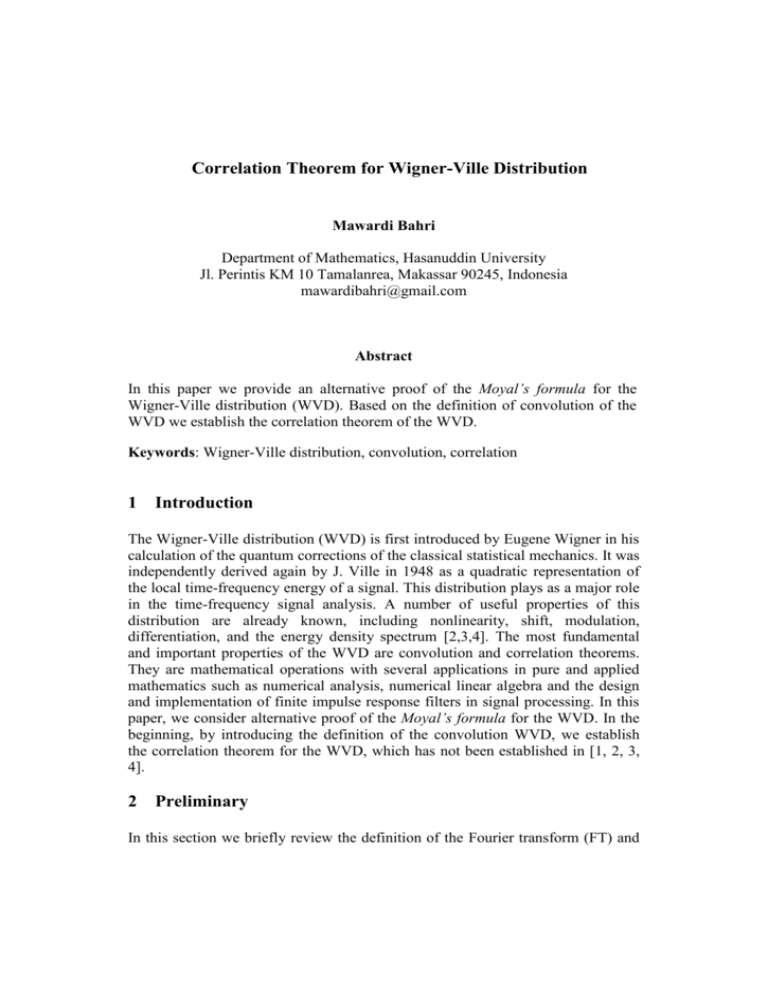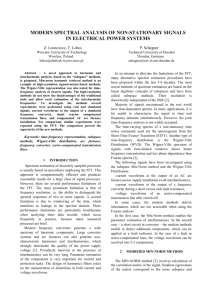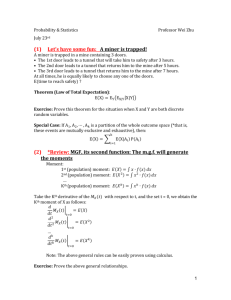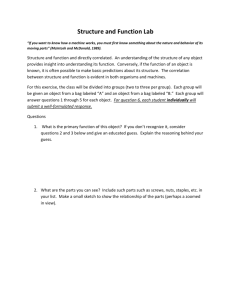View/Open - Hasanuddin University
advertisement

Correlation Theorem for Wigner-Ville Distribution
Mawardi Bahri
Department of Mathematics, Hasanuddin University
Jl. Perintis KM 10 Tamalanrea, Makassar 90245, Indonesia
mawardibahri@gmail.com
Abstract
In this paper we provide an alternative proof of the Moyal’s formula for the
Wigner-Ville distribution (WVD). Based on the definition of convolution of the
WVD we establish the correlation theorem of the WVD.
Keywords: Wigner-Ville distribution, convolution, correlation
1 Introduction
The Wigner-Ville distribution (WVD) is first introduced by Eugene Wigner in his
calculation of the quantum corrections of the classical statistical mechanics. It was
independently derived again by J. Ville in 1948 as a quadratic representation of
the local time-frequency energy of a signal. This distribution plays as a major role
in the time-frequency signal analysis. A number of useful properties of this
distribution are already known, including nonlinearity, shift, modulation,
differentiation, and the energy density spectrum [2,3,4]. The most fundamental
and important properties of the WVD are convolution and correlation theorems.
They are mathematical operations with several applications in pure and applied
mathematics such as numerical analysis, numerical linear algebra and the design
and implementation of finite impulse response filters in signal processing. In this
paper, we consider alternative proof of the Moyal’s formula for the WVD. In the
beginning, by introducing the definition of the convolution WVD, we establish
the correlation theorem for the WVD, which has not been established in [1, 2, 3,
4].
2 Preliminary
In this section we briefly review the definition of the Fourier transform (FT) and
basic properties. For a complex-valued function f defined on the real line ℝ, the
complex conjugate of f is the function𝑓 ̅ given by
𝑓 (̅ 𝑥) = ̅̅̅̅̅̅
𝑓(𝑥) for every real number x.
Definition 2.1 (Fourier Transform) Let f be in 𝐿2 (ℝ). Then Fourier transform
(FT) of complex function f is defined by
∞
ℱ {𝑓}(𝜔) = 𝑓̂(𝜔) = ∫−∞ 𝑓(𝑥)𝑒 −𝑖𝜔𝑥 𝑑𝑥.
(1)
In inner product notation, the FT defined in (1) can be also be expressed as
𝑓̂(𝜔) = (𝑓, 𝑒 𝑖𝜔𝑥 ).
The norm of the above inner product is given by
∞
(𝑓, 𝑓) = ∫−∞|𝑓(𝑥)|2 𝑑𝑥 = ‖𝑓‖2.
Theorem 2.2 (Inversion Formula) Suppose that f ∈ 𝐿2 (ℝ) and ℱ{𝑓} ∈ 𝐿1 (ℝ),
the inverse FT of the function f is given by
1 ∞
ℱ −𝚤 [ℱ{𝑓}](𝑥) = 𝑓(𝑥) = 2𝜋 ∫−∞ 𝑓̂(𝜔) 𝑒 𝑖𝜔𝑥 𝑑𝜔.
(2)
We first observe that for a special case the function 𝑓̂(𝜔) = 1we obtain the
Dirac’s delta function. That is
1 ∞
𝛿(𝑥) = 2𝜋 ∫−∞ 𝑒 𝑖𝜔𝑥 𝑑𝜔.
(3)
In the following we introduce the convolution and correlation definitions and
relationship among convolution, correlation and the FT.
Definition 2. 3 (Convolution) For two complex functions 𝑓, 𝑔 ∈ 𝐿2 (ℝ), the
convolution of 𝑓 and 𝑔, denoted 𝑓 ⋆ 𝑔, is defined by
∞
(𝑓 ⋆ 𝑔)(𝑥) = ∫−∞ 𝑓(𝑡)𝑔(𝑥 − 𝑡)𝑑𝑡.
(4)
2 (ℝ).
Theorem 2.4 Suppose that 𝑓, 𝑔 ∈ 𝐿
Then the FT of convolution of the two
complex functions is given by
ℱ{𝑓 ⋆ 𝑔}(𝜔) = ℱ{𝑓}(𝜔)ℱ{𝑔}(𝜔).
(5)
Next, let us examine how the FT behaves under correlations. First, we give the
definition of the correlation of two complex functions.
Definition 2. 6 (Correlation) For 𝑓, 𝑔 ∈ 𝐿2 (ℝ), the correlation of two complex
functions is defined by
∞
(𝑓 ⋄ 𝑔)(𝑥) = ∫−∞ 𝑓(̅ 𝑡)𝑔(𝑡 + 𝑥) 𝑑𝑡.
(6)
Theorem 2.4 Suppose that 𝑓, 𝑔 ∈ 𝐿2 (ℝ). Then the FT of correlation of two
complex functions is given by
̅
ℱ{𝑓 ⋄ 𝑔}(𝜔) = ℱ{𝑓}(−𝜔)ℱ{𝑔}(𝜔).
(7)
Or, equivalently,
∞ ̅̅̅̅̅̅̅̅̅̅̅
1
(𝑓 ⋄ 𝑔)(𝑥) =
ℱ{𝑔}(𝜔)𝑒 𝑖𝜔𝑥 𝑑𝜔.
(8)
∫ ℱ{𝑓}(𝜔)
2𝜋 −∞
3 Wigner-Ville Distribution
Here we describe the basic facts of the WVD, which will be needed to derive the
main result of the paper. First we give the definition of the cross WVD and auto
WVD.
Definition 3.1 (Cross Wigner-Ville Distribution) If two signals f, g ∈ 𝐿2 (ℝ), the
cross Wigner-Ville distribution of f and g is defined by
∞
𝑥 ̅̅̅̅̅̅̅̅̅̅̅̅
𝑥
𝑊𝑓,𝑔 (𝑡, 𝜔) = ∫−∞ 𝑓 (𝑡 + 2) 𝑔 (𝑡 − 2) 𝑒 −𝑖𝜔𝑥 𝑑𝑥.
(9)
Roughly speaking, the cross Wigner-Ville distribution 𝑊𝑓,𝑔 (𝑡, 𝜔) can be
considered as a function which indicates the distribution of the signal energy over
space and frequency. Obviously, if 𝑓 = 𝑔, then 𝑊𝑓,𝑓 (𝑡, 𝜔) = 𝑊𝑓 (𝑡, 𝜔) is called
the auto Wigner-Ville distribution. That is
∞
𝑥 ̅̅̅̅̅̅̅̅̅̅̅̅
𝑥
𝑊𝑓 (𝑡, 𝜔) = ∫−∞ 𝑓 (𝑡 + 2) 𝑓 (𝑡 − 2) 𝑒 −𝑖𝜔𝑥 𝑑𝑥.
(10)
Often both the cross WVD and the auto WVD are usually referred to simply as
the WVD. We should remember that the WVD is a nonlinear time frequency
transform because the signal enters integral more than once. It is obvious that if
𝑥 ̅̅̅̅̅̅̅̅̅̅̅̅
𝑥
𝑅𝑓,𝑔 (𝑡, 𝑥) = 𝑓 (𝑡 + 2) 𝑔 (𝑡 − 2), then the cross WVD is the FT of the function
𝑅𝑓,𝑔 (𝑡, 𝑥) with respect to 𝑥, i.e.,
𝑊𝑓,𝑔 (𝑡, 𝜔) = ℱ{𝑅𝑓,𝑔 (𝑡, 𝑥)}(𝜔).
(11)
Applying the Dirac’s delta function defined in equation (3) we get the FT of the
WVD with respect to 𝜔 (see [2, 3]) as
𝜎
̂𝑓,𝑔 (𝑡, 𝜎) =2𝜋 𝑓 (𝑡 − 𝜎) ̅̅̅̅̅̅̅̅̅̅̅̅
𝑊
𝑔 (𝑡 + ).
2
2
(12)
Some important properties of the WVD are summarized as follows. Let f, g ∈
𝐿2 (ℝ). Denote by 𝜏𝑘 is a shift operator defined by 𝜏𝑘 𝑓(𝑥) = 𝑓(𝑥 − 𝑘) and by
𝕄𝜔0 is a modulation operator defined 𝕄𝜔0 𝑓(𝑥) = 𝑒 𝑖𝜔0 𝑥 𝑓(𝑥).
1. Complex conjugation
̅̅̅̅̅̅̅̅̅̅̅̅̅
𝑊𝑓,𝑔 (𝑡, 𝜔) = 𝑊𝑔,𝑓 (𝑡, 𝜔).
2.
Time marginal
1 ∞
∫ 𝑊 (𝑡, 𝜔)𝑑𝜔
2𝜋 −∞ 𝑓,𝑔
3.
4.
5.
6.
= |𝑓(𝑡)|2 .
Frequency marginal
∞
∫−∞ 𝑊𝑓,𝑔 (𝑡, 𝜔)𝑑𝑡 = |ℱ{𝑓}(𝜔)|2.
Energy Distribution
∞
∞
1 ∞
1 ∞
∫ ∫ 𝑊 (𝑡, 𝜔)𝑑𝜔𝑑𝑡 = ∫−∞|𝑓(𝑡)|2 𝑑𝑡 = 2𝜋 ∫−∞|ℱ{𝑓}(𝜔)|2 𝑑𝜔.
2𝜋 −∞ −∞ 𝑓,𝑔
Shift
𝑊𝜏𝑘𝑓,𝜏𝑘𝑔 (𝑡, 𝜔) = 𝑊𝑓,𝑔 (𝑡 − 𝑎, 𝜔).
Modulation
𝑊𝕄𝜔 𝑓,𝕄𝜔 𝑔 (𝑡, 𝜔) = 𝑊𝑓,𝑔 (𝑡, 𝜔 − 𝜔0 ).
0
0
7.
Inversion formula
∞
1
𝑡
𝑓(𝑡) =
∫ 𝑊𝑓,𝑔 ( , 𝜔) 𝑒 𝑖𝜔𝑡 𝑑𝜔,
̅̅̅̅̅̅ −∞
2
2𝜋𝑔(0)
̅̅̅̅̅̅ ≠ 0.
provided 𝑔(0)
To illustrative the application of the properties mentioned above, we shall give an
example of the WVD (compare to [6]).
Example. Consider a chirp signal which is modulated by a Gaussian envelope
𝑎 1/4
−𝑎𝑡 2
𝑓(𝑡) = (𝜋)
exp (
−𝑎𝑡 2
2
+
𝑖𝑏𝑡 2
+ 𝑖𝜔0 𝑡),
2
𝑖𝑏𝑡 2
where exp ( 2 ) is the Gaussian term, exp (
exp(𝑖𝜔0 𝑡) is a frequency-shifting term.
2
) is the chirp signal, and
An application of the WVD definition (10) we may compute the shift of the WVD
as
𝑊𝜏𝑘𝑓 (𝑡, 𝜔)
𝑎 1/2 ∞
−𝑎(𝑡 − 𝑘 + 𝑥/2)2 𝑖𝑏(𝑡 − 𝑘 + 𝑥/2)2
= ( ) ∫ exp (
+
+ 𝑖𝜔0 (𝑡 − 𝑘 + 𝑥/2))
𝜋
2
2
−∞
−𝑎(𝑡 − 𝑘 − 𝑥/2)2 𝑖𝑏(𝑡 − 𝑘 − 𝑥/2)2
× exp (
−
− 𝑖𝜔0 (𝑡 − 𝑘 − 𝑥/2))
2
2
× exp( −𝑖𝜔𝑥)𝑑𝑥
𝑥2
2
−𝑎
((𝑡
−
𝑘)
+
𝑡𝑥
−
𝑘𝑥
+
𝑎 1/2
4 ) 𝑖𝑏((𝑡 − 𝑘)2 + 𝑡(𝑥 − 𝑘))
= ( ) ∫ exp (
+
)
𝜋
2
2
−∞
∞
𝑥
× exp (𝑖𝜔0 (𝑡 − 𝑘 + )) 𝑑𝑥
2
𝑥2
−𝑎 ((𝑡 − 𝑘)2 + 4 − 𝑡𝑥 + 𝑘𝑥) 𝑖𝑏((𝑡 − 𝑘)2 − 𝑡(𝑥 − 𝑘))
× exp (
−
)
2
2
𝑥
× exp (−𝑖𝜔0 (𝑡 − 𝑘 − )) exp( −𝑖𝜔𝑥)𝑑𝑥
2
𝑎 1/2
= (𝜋 )
2
∞
−𝑎𝑥 2
𝑒 −𝑎(𝑡−𝑘) ∫−∞ exp (
4
) exp(𝑖𝑏(𝑡 − 𝑘)𝑥 +
𝑖𝜔0 𝑥) exp( −𝑖𝜔𝑥) 𝑑𝑥.
Taking the FT of shift property of the Gaussian function we finally get
2
2
𝑊𝜏𝑘𝑓 (𝑡, 𝜔) = 2 𝑒 −𝑎(𝑡−𝑘) 𝑒 −(𝜔−𝑏(𝑡−𝑘)−𝜔0 ) /𝑎.
Now we provide the alternative proof of the Moyal’s formula as follows.
Theorem (Moyal’s formula) For any complex functions 𝑓1 , 𝑓2 , 𝑔1 , 𝑔2 ∈ 𝐿2 (ℝ),
then the following results hold
∞ ∞
1
̅̅̅̅̅̅̅̅̅̅̅̅̅̅̅
̅̅̅̅̅̅̅̅̅̅
𝜋 ∫−∞ ∫−∞ 𝑊𝑓1 ,𝑔1 (𝑡, 𝜔) 𝑊
(13)
𝑓2 ,𝑔2 (𝑡, 𝜔)𝑑𝜔𝑑𝑡 = (𝑓1 , 𝑓2 )(𝑔1 , 𝑔2 ).
2
In particular, we have
∞
1
∞
2
𝜋 ∫−∞ ∫−∞|𝑊𝑓,𝑔 (𝑡, 𝜔)| 𝑑𝜔𝑑𝑡 = ‖𝑓‖2 ‖𝑔‖2 ,
2
and
1
2
∞ ∞
𝜋 ∫−∞ ∫−∞ 𝑊𝑓 (𝑡, 𝜔) ̅̅̅̅̅̅̅̅̅̅̅
𝑊𝑔 (𝑡, 𝜔)𝑑𝜔𝑑𝑡 = |(𝑓, 𝑔)|2 .
Proof. The Parseval’s formula of the FT applies to 𝜔-integral and yields
∞
∞
̅̅̅̅̅̅̅̅̅̅̅̅̅̅̅
∫ ∫ 𝑊𝑓1 ,𝑔1 (𝑡, 𝜔) 𝑊
𝑓2 ,𝑔2 (𝑡, 𝜔)𝑑𝜔𝑑𝑡
−∞ −∞
∞
∞
= ∫ ( ∫ ℱ{𝑅𝑓1 ,𝑔1 (𝑡, 𝑥)}(𝜔) ̅̅̅̅̅̅̅̅̅̅̅̅̅̅̅̅̅̅̅̅̅̅̅
ℱ{𝑅𝑓2 ,𝑔2 (𝑡, 𝑥)}(𝜔)𝑑𝜔) 𝑑𝑡
−∞
−∞
∞
1 ∞
̅̅̅̅̅̅̅̅̅̅̅̅̅̅
= 2𝜋 ∫−∞(∫−∞ 𝑅𝑓1 ,𝑔1 (𝑡, 𝑥)𝑅
𝑓2 ,𝑔2 (𝑡, 𝑥) 𝑑𝑥) 𝑑𝑡.
Therefore, we further get
∞
∞
̅̅̅̅̅̅̅̅̅̅̅̅̅̅̅
∫ ∫ 𝑊𝑓1 ,𝑔1 (𝑡, 𝜔) 𝑊
𝑓2 ,𝑔2 (𝑡, 𝜔)𝑑𝜔𝑑𝑡
−∞ −∞
∞
1 ∞
𝑥 ̅̅̅̅̅̅̅̅̅̅̅̅̅
𝑥
𝑥 ̅̅̅̅̅̅̅̅̅̅̅̅̅
𝑥
=
∫ ∫ 𝑓1 (𝑡 + ) 𝑔1 (𝑡 − ) 𝑔2 (𝑡 − ) 𝑓2 (𝑡 + ) 𝑑𝑥𝑑𝑡,
2𝜋 −∞
2
2
2
2
−∞
𝑥
𝑥
which is, due to change of variables, y= 𝑡 + 2 and 𝑧 = 𝑡 − 2,
∞
∞
2 ∞ ∞
̅̅̅̅̅̅̅̅̅̅̅̅̅̅̅
̅̅̅̅̅̅̅
̅̅̅̅̅̅̅
∫ ∫ 𝑊𝑓1 ,𝑔1 (𝑡, 𝜔) 𝑊𝑓2 ,𝑔2 (𝑡, 𝜔)𝑑𝜔𝑑𝑡 = ∫ ∫ 𝑓1 (𝑦)𝑔
1 (𝑧)𝑔2 (𝑧)𝑓2 (𝑦)𝑑𝑦𝑑𝑧
𝜋
−∞ −∞
−∞ −∞
2
̅̅̅̅̅̅̅̅̅̅
= 𝜋 (𝑓1 , 𝑓2 )(𝑔
1 , 𝑔2 ).
This proves the proof of (13).
4
Correlation Theorem for WVD
The convolution is very important in the theory of linear time-invariant (LTI)
systems (also known as linear shift-invariant systems for two-and higher
dimensional signals). Based on the correlation definition mentioned in (6) we
establish two following correlation theorems for the WVD.
Theorem 4.1 For any two signals 𝑓, 𝑔 ∈ 𝐿2 (ℝ), the following result holds
∞ ̅̅̅̅̅̅̅̅̅̅̅̅
𝑊𝑓⋄𝑔 (𝑡, 𝜔) = ∫−∞ 𝑊
(14)
𝑓 (𝑢, 𝜔) 𝑊𝑔 (𝑢 + 𝑡, 𝜔)𝑑𝑢.
Proof. By the WVD and correlation definitions we immediately get
∞
𝑥 ̅̅̅̅̅̅̅̅̅̅̅̅̅̅̅̅̅̅̅̅
𝑥
𝑊𝑓⋄𝑔 (𝑡, 𝜔) = ∫ (𝑓 ⋄ 𝑔) (𝑡 + ) (𝑓 ⋄ 𝑔) (𝑡 − ) 𝑒 −𝑖𝜔𝑥 𝑑𝑥
2
2
−∞
̅̅̅̅̅̅̅̅̅̅̅̅̅̅̅̅̅̅̅̅
∞ ∞ ̅̅̅̅̅̅
∞
𝑥
𝑥
= ∫−∞ ∫−∞ 𝑓(𝜏)
𝑔 (𝜏 + (𝑡 + 2)) 𝑑𝜏 ∫−∞ 𝑓(𝜁) 𝑔 (𝜁 + (𝑡 − 2)) 𝑑𝜏𝑒 −𝑖𝜔𝑥 𝑑𝑥.
𝑝
𝑝
Putting 𝜏 = 𝑢 + 2 , 𝜁 = 𝑢 − 2 and 𝑥 = 𝑞 − 𝑝, we easily get
∞
∞ ∞ ̅̅̅̅̅̅̅̅̅̅̅̅
𝑝
𝑝
𝑥
𝑊𝑓⋄𝑔 (𝑡, 𝜔) = ∫−∞ ∫−∞ ∫−∞ 𝑓 (𝑢 + 2) 𝑔 (𝑢 + 2 + (𝑡 + 2))
𝑝 ̅̅̅̅̅̅̅̅̅̅̅̅̅̅̅̅̅̅̅̅̅̅̅̅̅̅
𝑝
𝑥
× 𝑓 (𝑢 − ) 𝑔 (𝑢 − + (𝑡 − )) 𝑒 −𝑖𝜔(𝑞−𝑝) 𝑑𝑝𝑑𝑞𝑑𝑢
2
2
2
∞
∞ ∞ ̅̅̅̅̅̅̅̅̅̅̅̅
𝑝
𝑝
𝑞 ̅̅̅̅̅̅̅̅̅̅̅̅̅̅̅̅̅
𝑞
= ∫−∞ ∫−∞ ∫−∞ 𝑓 (𝑢 + ) 𝑓 (𝑢 − ) 𝑔 (𝑢 + 𝑡 + ) 𝑔 (𝑢 − 𝑡 − )
2
2
2
2
×
𝑒 −𝑖𝜔(𝑞−𝑝) 𝑑𝑞𝑑𝑝𝑑𝑢.
Applying the definition of the WVD we obtain
∞
∞
̅̅̅̅̅̅̅̅̅̅̅̅
𝑝
𝑝
𝑊𝑓⋄𝑔 (𝑡, 𝜔) = ∫ ∫ 𝑓 (𝑢 + ) 𝑓 (𝑢 − ) 𝑒 𝑖𝜔𝑝 𝑑𝑝
2
2
−∞ −∞
∞
𝑞 ̅̅̅̅̅̅̅̅̅̅̅̅̅̅̅̅̅
𝑞
× ∫ 𝑔 (𝑢 + 𝑡 + ) 𝑔 (𝑢 + 𝑡 − ) 𝑒 −𝑖𝜔𝑞 𝑑𝑞𝑑𝑢
2
2
−∞
∞ ̅̅̅̅̅̅̅̅̅̅̅̅̅̅̅̅̅̅̅̅̅̅̅̅̅̅̅̅̅̅̅̅̅̅̅̅̅̅
∞
𝑝 ̅̅̅̅̅̅̅̅̅̅̅̅
𝑝
= ∫ ∫ 𝑓 (𝑢 + ) 𝑓 (𝑢 − ) 𝑒 −𝚤𝜔𝑝 𝑑𝑝
2
2
−∞ −∞
∞
𝑞 ̅̅̅̅̅̅̅̅̅̅̅̅̅̅̅̅̅
𝑞
× ∫ 𝑔 (𝑢 + 𝑡 + ) 𝑔 (𝑢 + 𝑡 − ) 𝑒 −𝑖𝜔𝑞 𝑑𝑞𝑑𝑢
2
2
−∞
∞ ̅̅̅̅̅̅̅̅̅̅̅̅
= ∫−∞ 𝑊𝑓 (𝑢, 𝜔) 𝑊𝑔 (𝑢 + 𝑡, 𝜔)𝑑𝑢.
From the above theorem, it can easily be seen that that the Wigner-Ville
distribution of the correlation of the two signals is the correlation in time of their
corresponding Wigner-Ville distributions.
Theorem 4.2 (Correlation with Respect to Both Variables) For any two
signals 𝑓, 𝑔 ∈ 𝐿2 (ℝ), the following result holds
(𝑊𝑓 ⋄ 𝑊𝑔 )(𝑎, 𝑏) = 2𝜋|(𝑓, ̅̅̅̅̅̅̅̅̅̅̅
𝕄𝑏 𝜏−𝑎 𝑔)|2 .
(15)
Proof. It readily follows from the correlation theorem (8) of the classical FT that
∞
̅̅̅̅̅̅̅̅̅̅̅
(𝑊𝑓 ⋄ 𝑊𝑔 )(𝑎, 𝑏) = ∫ 𝑊
𝑓 (𝑡, 𝜔) 𝑊𝑔 (𝑡 + 𝑎, 𝜔 + 𝑏)𝑑𝜔
=
−∞
1 ∞ ̅̅̅̅̅̅̅̅̅̅̅
̂ (𝑡, 𝜎) 𝑊
̂𝑔 (𝑡
∫ 𝑊
2𝜋 −∞ 𝑓
+ 𝑎, 𝜎)𝑒 𝑖𝑏𝜎 𝑑𝜎.
With the help of (12) we further obtain
∞
𝜎 ̅̅̅̅̅̅̅̅̅̅̅̅
𝜎
𝜎 ̅̅̅̅̅̅̅̅̅̅̅̅̅̅̅̅̅̅
𝜎
= 2𝜋 ∫ 𝑓 (𝑡 − ) 𝑓 (𝑡 + ) 𝑔 (𝑡 + 𝑎 − ) 𝑔 (𝑡 + 𝑎 + ) 𝑒 𝑖𝑏𝜎 𝑑𝜎,
2
2
2
2
−∞
𝜎
which is, due to the change of variables 𝜏 = 𝑡 − 2 ,
∞
̅̅̅̅̅̅̅̅̅̅̅̅
̅̅̅̅̅̅̅̅̅̅̅̅̅̅̅̅̅̅
= 4𝜋 ∫ 𝑓(𝜏)𝑓(2𝑡
− 𝜏) 𝑔(𝑎 + 𝜏)𝑔(𝑎
+ 2𝑡 − 𝜏)𝑒 𝑖2𝑏(𝜏−𝑡) 𝑑𝜏.
−∞
Integrating the above expression with respect to 𝑡 yields
∞
∞
̅̅̅̅̅̅̅̅̅̅̅
∫ ∫ 𝑊
𝑓 (𝑡, 𝜔) 𝑊𝑔 (𝑡 + 𝑎, 𝜔 + 𝑏)𝑑𝜔𝑑𝑡
−∞ −∞
∞
∞
̅̅̅̅̅̅̅̅̅̅̅̅
= 4𝜋 ∫ 𝑓(𝜏) 𝑔(𝑎 + 𝜏)𝑒 𝑖2𝑏𝜏 𝑑𝜏 ∫ 𝑓(2𝑡
− 𝜏) ̅̅̅̅̅̅̅̅̅̅̅̅̅̅̅̅̅̅
𝑔(𝑎 + 2𝑡 − 𝜏) 𝑒 −𝑖2𝑏𝑡 𝑑𝑡
−∞
−∞
which is, by substitution of 𝑢 = 2𝑡 − 𝜏,
∞
∞
̅̅̅̅̅̅̅̅̅̅̅
∫ ∫ 𝑊
𝑓 (𝑡, 𝜔) 𝑊𝑔 (𝑡 + 𝑎, 𝜔 + 𝑏)𝑑𝜔𝑑𝑡
−∞ −∞
∞
∞
̅̅̅̅̅̅ 𝑒 −𝑖𝑏𝑢 ̅̅̅̅̅̅̅̅̅̅̅̅
= 2𝜋 ∫ 𝑓(𝜏) 𝑔(𝜏 + 𝑎)𝑒 𝑖𝑏𝜏 𝑑𝜏 ∫ 𝑓(𝑢)
𝑔(𝑢 + 𝑎)𝑑𝑢
−∞
−∞
= 2𝜋(𝑓, ̅̅̅̅̅̅̅̅̅̅̅
𝕄𝑏 𝜏−𝑎 𝑔)(𝑓̅, 𝕄𝑏 𝜏−𝑎 𝑔)
̅̅̅̅̅̅̅̅̅̅̅̅̅̅̅̅
̅̅̅̅̅̅̅̅̅̅̅
̅̅̅̅̅̅̅̅̅̅̅
= 2𝜋(𝑓, 𝕄
𝑏 𝜏−𝑎 𝑔)(𝑓, 𝕄𝑏 𝜏−𝑎 𝑔).
This is desired result.
Acknowledgements
This work is partially supported by Hibah Penelitian Kompetisi Internal tahun
2013 (No. 110/UN4-.42/LK.26/SP-UH/2013) from the Hasanuddin University,
Indonesia.
References
[1] L. Cohen, Time-Frequency Distribution- A Review, Proceedings of the
IEEE, 77 (7), 1989, 941-980.
[2] L. Debnath, B. V. Shankara and N. Rao, On New Two-Dimensional
Wigner-Ville Nonlinear Integral Transforms and Their Basic Properties,
[3]
[4]
[5]
[6]
Integral Transforms and Special Functions, 21(3) (2010), 165-174.
L. Debnath, Wavelet Transform and Their Applications, Birkhauser, Boston,
2002.
L. Debnath, Recent developments in the Wigner–Ville distribution and the
time–frequency signal analysis, Proc. Indian Natl. Sci. Acad. , 68A (2002),
35–56.
K. Groechenig, Foundation of Time-Frequency Analysis, Birkhauser, Boston,
2001.
L. Cohen, Time-Frequency Analysis, Prentice Hall PTR, Englewood Cliffs,
New Jersey, 1995.






